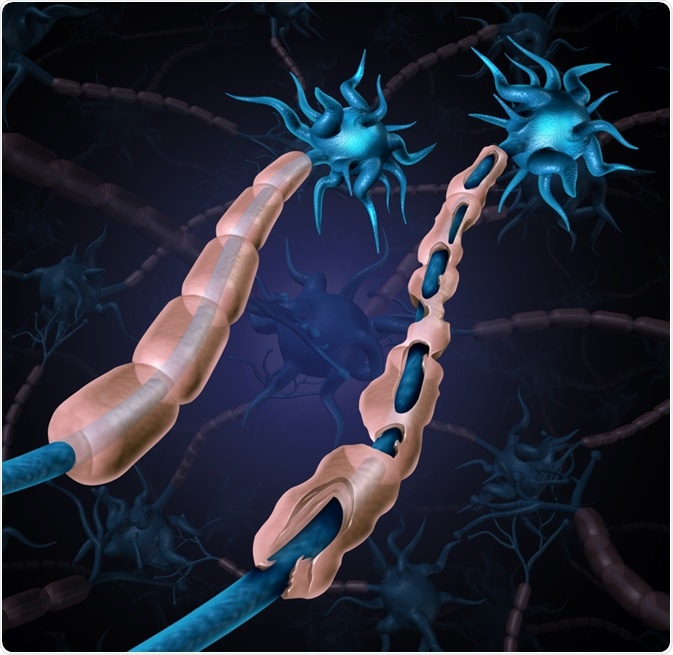Guillain-Barre syndrome is a rare autoimmune condition in which the immune system attacks peripheral nerves and damages the myelin insulation. Symptoms rapidly progress from pain to muscle weakness and even paralysis. Although Guillain-Barre usually affects the hands, feet, and limbs, it can be life-threatening when nerves controlling breathing are affected.
 Lightspring | Shutterstock
Lightspring | Shutterstock
Guillain-Barre syndrome has been clinically sub-classified into several variants1, but specific biomarkers for each of the subtypes have not been well defined. Furthermore, there are several other conditions that can cause similar symptoms, such as inflammatory demyelination disorders of the central nervous system (IDDs).
Consequently, Guillain-Barre syndrome can be difficult to diagnose, especially in younger patients2. This can be seriously detrimental to patient outcomes since early effective treatment is critical to preventing rapid progression to a severe clinical course.
Greater understanding of the underlying pathology of Guillain-Barre syndrome is thus needed to facilitate its accurate diagnosis and improve patient prognoses3.
Metabolomic analyses
Metabolomic analysis enables high-throughput molecular profiling, which is a valuable tool in biomarker identification. It evaluates all the small molecule intermediates and products of metabolism present in the cell at a given time.
This provides a unique chemical fingerprint that can be compared between different situations to identify the specific cellular processes that are affected. As all the entities within a cell are measured there is no need for prior understanding of a process in order to perform a metabolomic investigation.
An untargeted metabolomic study of blood plasma from patients with Guillain-Barre indicated that lipid metabolism was disturbed in this condition and proposed some molecular indicators for the different subtypes4. However, analysis of cerebral spinal fluid may provide more information since it is in direct contact with the myelin sheath and nerve exon, the components that are damaged in Guillain-Barre syndrome.
Identifying biomarkers of GBS
A metabolomic analysis of CSF has recently been conducted using samples from 86 patients with Guillain-Barre syndrome and 20 healthy controls5. Lipidomic profiles were determined in parallel. Metabolites were analyzed by one-dimensional 1H-Overhauser effect nuclear magnetic resonance spectroscopy (NOESY NMR) using a Bruker ASCEND III 600 spectrometer equipped with a cryoprobe.
The metabolic phenotypes obtained were compared between the three most common clinical subtypes of GBS (acute inflammatory demyelinating polyneuropathy [AIDP], acute motor axonal neuropathy [AMAN], and Miller Fisher syndrome [MFS]), healthy controls and with data previously obtained for patients with the IDDs, multiple sclerosis, and neuromyelitis optica.
Primary metabolite profiles revealed specific metabolic traits that were unique to Guillain-Barre syndrome and inflammatory demyelination disorders (IDDs). The Guillain-Barre samples showed elevated levels of glucose and ketone bodies, whereas glucose was lower in IDD samples. Lactate concentration also differed significantly between the two classes of disease, being elevated in IDD but reduced in the Guillain-Barre syndrome samples.
Biomarker analysis using a panel of 10 primary metabolites enabled reasonably good discrimination between the three Guillain-Barre subtypes, healthy controls, and inflammatory demyelination disorders. The robustness of the biomarker panel was vigorously validated by multi-step statistical evaluation.
The primary metabolic profiles were similar for AIDP and AMAN Guillain-Barre syndrome subtypes, which reflects the comparable clinical presentation. In contrast, the symptoms and metabolic profiles of the MFS subtype of GBS are clearly distinct from the AIDP and AMAN GBS subtypes.
Depletion of creatine and lysine were specific to the MFS subtype, whereas changes in histidine levels were exclusively observed in the AIDP subtype.
The lipidomic analysis revealed that significant elevations of lyso-phosphatidylcholines were unique to the AIDP subtype of Guillain-Barre syndrome and that increases in the levels of sphingomyelins were characteristic of the AMAN subtype.
In addition, the metabolome-wide multivariate correlation analysis suggested a link between the level of disability (GBS Hughes score) and the level of lactate, 1-monopalmitin, 1-monostearin, and sphingomyelins in the CSF. This was particularly true in patients with the AMAN subtype.
This study has identified biomarkers that could facilitate the diagnosis of the different subtypes of Guillain-Barre syndrome, enabling treatment to be tailored appropriately. In addition, potential biochemical links with the pathology and severity of the condition were identified, which could inform a patient’s prognosis.
Distinctive biochemical differences were also observed between Guillain-Barre syndrome and inflammatory demyelination disorders. The identification of these differences is an important step towards improving the differential diagnosis of GBS and IDDs, as well as disorders with similar presentations.
It is hoped that these findings will enable early and precise diagnosis of Guillain-Barre syndrome. This, in turn, will mean that patients can receive the treatment they need much earlier, increasing the success rate in reducing the severity of the disease course, the level of pain, and the risk of residual deficits.
References
- Kim J K, et al. Journal of Clinical Neurology 2014;10:94–100.
- Walgaard C, et al. Neurology 2011;76:968–975.
- Van den Berg, B. et al. Nature Reviews Neurology 2014;10:469.
- Tang H-Y, et al. Scientific reports 2017;7:8140.
- Park SJ, et al. Scientific Reports 2019;9:article number: 1077. https://www.nature.com/articles/s41598-018-37572-w#Sec9
About Bruker BioSpin - NMR, EPR and Imaging
 Bruker BioSpin offers the world's most comprehensive range of NMR and EPR spectroscopy and preclinical research tools. Bruker BioSpin develops, manufactures and supplies technology to research establishments, commercial enterprises and multi-national corporations across countless industries and fields of expertise.
Bruker BioSpin offers the world's most comprehensive range of NMR and EPR spectroscopy and preclinical research tools. Bruker BioSpin develops, manufactures and supplies technology to research establishments, commercial enterprises and multi-national corporations across countless industries and fields of expertise.
Sponsored Content Policy: News-Medical.net publishes articles and related content that may be derived from sources where we have existing commercial relationships, provided such content adds value to the core editorial ethos of News-Medical.Net which is to educate and inform site visitors interested in medical research, science, medical devices and treatments.